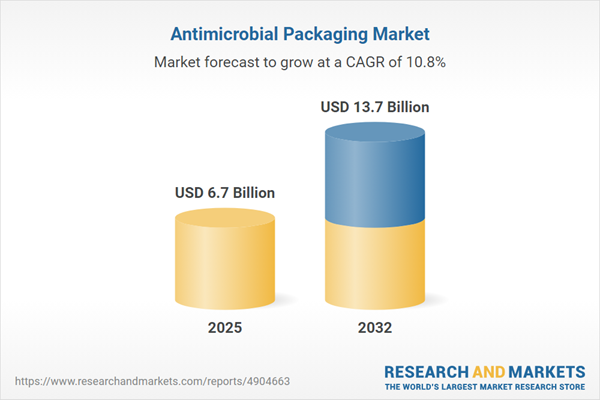Speak directly to the analyst to clarify any post sales queries you may have.
The antimicrobial packaging market is rapidly evolving to meet the demands of food safety, product integrity, and extended shelf life for industries facing increasingly rigorous standards. As global supply chains become more complex and consumer expectations intensify, companies are rethinking packaging strategies to ensure product protection and regulatory compliance.
Market Snapshot: Strong Momentum and Future Growth in Antimicrobial Packaging
The Antimicrobial Packaging Market grew from USD 6.03 billion in 2024 to USD 6.70 billion in 2025. It is expected to continue growing at a CAGR of 10.78%, reaching USD 13.70 billion by 2032.
This trajectory reflects expanding adoption across food, pharmaceutical, and consumer goods sectors, with investments in R&D accelerating the pace of technological innovation. Heightened global awareness of food safety, stringent compliance mandates, and persistent pressure to reduce spoilage are all shaping the current landscape.
Scope & Segmentation: Diverse Applications and Emerging Technologies
- Packaging Types: Flexible packaging (including multilayer films, plastic films, flat pouches, stand-up pouches, flow wraps, and skin film) and rigid packaging (glass and plastic bottles, boxes, cans, PET trays, PP trays).
- End-Use Applications: Bakery products (bread, pastries), cosmetics, dairy items (cheese, milk), fresh produce (fruits, vegetables), meat and seafood (fresh and processed).
- Antimicrobial Agents: Enzymes, metals and metal ions (copper oxide, copper sulfate, nanosilver, silver ions, zinc ions, zinc oxide), organic acids, and polymer-based agents.
- Material Types: Bioplastics (PHA, PLA), coated and uncoated paperboard, and traditional polymers (polyethylene, polypropylene, polystyrene).
- Regional Coverage: Americas (United States, Canada, Mexico, Brazil, Argentina, Chile, Colombia, Peru), Europe, Middle East & Africa (including United Kingdom, Germany, France, Russia, Italy, Spain, Netherlands, Sweden, Poland, Switzerland, United Arab Emirates, Saudi Arabia, Qatar, Turkey, Israel, South Africa, Nigeria, Egypt, Kenya), and Asia-Pacific (China, India, Japan, Australia, South Korea, Indonesia, Thailand, Malaysia, Singapore, Taiwan).
- Key Companies: Amcor plc, Berry Global Group, Sonoco Products, Sealed Air Corporation, Huhtamaki Oyj, Ahlstrom-Munksjö Oyj, BASF SE, The 3M Company, Clariant AG, Mitsubishi Gas Chemical, and Dow, Inc.
Key Takeaways: Strategic Insights for Antimicrobial Packaging Stakeholders
- Growing regulatory scrutiny, particularly across North America, Europe, and Asia-Pacific, is driving the push for validated antimicrobial performance and increased investment in research-driven packaging solutions.
- Advancements in nanocomposite materials and bio-based polymers are opening new avenues for sustainable packaging, responding to both environmental concerns and market preferences for product transparency and safety.
- Intelligent packaging solutions, equipped with sensors and indicators, are enabling real-time monitoring of product quality, enhancing cold chain visibility, and offering actionable data for process optimization.
- Collaboration across the supply chain—including raw material suppliers, packaging manufacturers, and regulatory bodies—is accelerating the commercialization of innovative technologies and harmonizing standards.
- Rising demand in emerging markets, fueled by urbanization and expanding retail infrastructure, is reshaping the regional landscape and prompting localized material development and sourcing strategies.
Tariff Impact: Adjusting Supply Strategies in Response to U.S. Policies
The scheduled United States tariffs for 2025 are reshaping cost structures for global antimicrobial packaging manufacturers. Duties on imported metals and polymer resins are prompting companies to evaluate local production, invest in alternative antimicrobial agents, and pursue scenario-based sourcing to safeguard profitability and supply chain resilience.
Research Methodology & Data Sources
This analysis integrates primary interviews with industry executives, regulatory experts, and researchers, alongside quantitative surveys from packaging and logistics sectors. Secondary data includes regulatory filings, patent databases, trade publications, and industry white papers. Rigorous cross-validation, scenario modeling, and independent expert review ensure credibility throughout the findings.
Why This Report Matters: Decision-Ready Insights for Senior Leaders
- Enables executive teams to align packaging investments with evolving safety, regulatory, and sustainability expectations worldwide.
- Supports strategic planning, from technology adoption to navigating tariff-driven cost shifts and identifying growth markets by segment and region.
- Helps companies anticipate and address operational challenges—such as compliance, product quality, and supply chain vulnerabilities—with actionable data and market benchmarks.
Conclusion
Senior leaders seeking to enhance supply chain resilience and capitalize on market trends will find clear, data-driven direction in this antimicrobial packaging market analysis. A proactive, cross-functional approach to investments in technology and compliance will help secure competitive advantage in a rapidly evolving landscape.
Additional Product Information:
- Purchase of this report includes 1 year online access with quarterly updates.
- This report can be updated on request. Please contact our Customer Experience team using the Ask a Question widget on our website.
Table of Contents
3. Executive Summary
4. Market Overview
7. Cumulative Impact of Artificial Intelligence 2025
Companies Mentioned
The companies profiled in this Antimicrobial Packaging market report include:- Amcor plc
- Berry Global Group, Inc.
- Sonoco Products Company
- Sealed Air Corporation
- Huhtamaki Oyj
- Ahlstrom-Munksjö Oyj
- BASF SE
- The 3M Company
- Clariant AG
- Mitsubishi Gas Chemical Company, Inc.
- Dow, Inc.
Table Information
| Report Attribute | Details |
|---|---|
| No. of Pages | 199 |
| Published | November 2025 |
| Forecast Period | 2025 - 2032 |
| Estimated Market Value ( USD | $ 6.7 Billion |
| Forecasted Market Value ( USD | $ 13.7 Billion |
| Compound Annual Growth Rate | 10.7% |
| Regions Covered | Global |
| No. of Companies Mentioned | 12 |









